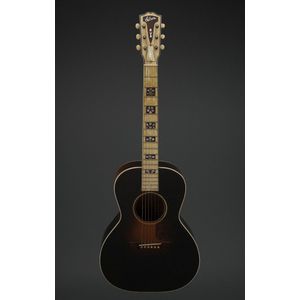Vintage Gibson Acoustic Guitar with Mother-of-Pearl Inlay
American century sunburst acoustic guitar, by Gibson, serial number 623, Kalamazoo, circa 1933, the Gibson logo inlaid in Mother-of-pearl to headstock, the fingerboard veneered in celluloid plastic (pearloid) and inlaid with mother-of-pearl, 102 cm long
You must be a subscriber, and be logged in to view price and dealer details.
Subscribe Now to view actual auction price for this item
When you subscribe, you have the option of setting the currency in which to display prices to $Au, $US, $NZ or Stg.
This item has been sold, and the description, image and price are for reference purposes only.
- Circa - A Latin term meaning 'about', often used in the antique trade to give an approximate date for the piece, usually considered to be five years on either side of the circa year. Thus, circa 1900 means the piece was made about 1900, probably between 1895 and 1905. The expression is sometimes abbreviated to c.1900.
- Mother-Of-Pearl - Mother-of-pearl, technical name "nacre", is the inner layer of a sea shell. The iridescent colours and strength of this material were widely used in the nineteenth century as an inlay in jewellery, furniture, (especially papier mache furniture) and musical instruments.
In the early 1900s it was used to make pearl buttons. Mother-of-pearl is a soft material that is easily cut or engraved.
Nowadays it is a by-product of the oyster, freshwater pearl mussel and abalone industries. - Celluloid - In 1864 an American scientist by the name of Parkes mixed camphor with nitrocellulose, etc. The result was what came to be known as "celluloid", the first form of plastic, and a product for which Parkes could find no use.
Some time later when the supplies of ivory for making billiard balls were becoming difficult to obtain, an inventor produced a perfect billiard ball from a mould using "celluloid".
Toys, dolls and other products such as combs, cutlery handles and costume jewellery made from celluloid began appearing on the market from 1913 and continued to do so until the early 1950s by which time it was superseded by more modern products due to safety concerns because it was highly flammable and brittle product.
This item has been included into following indexes:
Visually similar items

A 19th century Meissen porcelain figure, of a woman in 18th century dress playing a spinet, blue crossed swords mark, impressed numbers and incised marks. Height 12 cm
Sold by
in
for
You can display prices in $Au, $US, $NZ or Stg.

A 19th century French bronze figure of 'L'Etoile du Matin' signed A.Goudez. 45 cm high
Sold by
in
for
You can display prices in $Au, $US, $NZ or Stg.

Chinese silver gilt, enamel and green gem bracelet
Sold by
in
for
You can display prices in $Au, $US, $NZ or Stg.

Stanley No.104 smoothing plane
Sold by
in
for
You can display prices in $Au, $US, $NZ or Stg.
